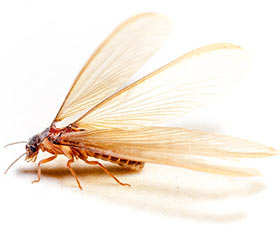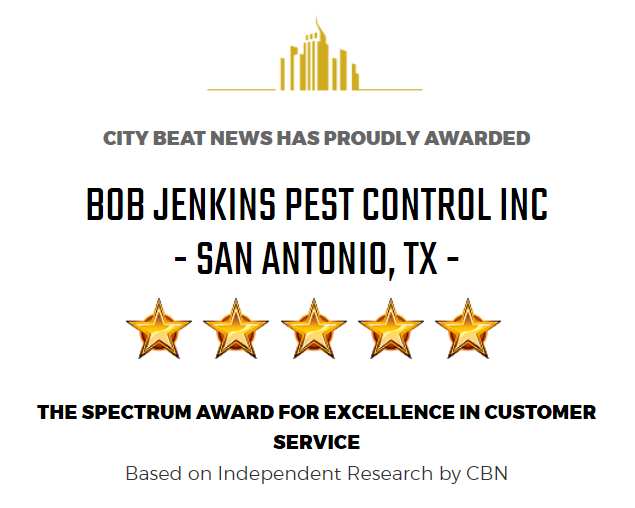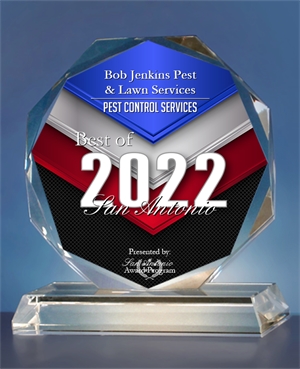San Antonio Termite Inspection – Termite Control

Termites are beneficial organisms that eat dead wood and turn it into rich humus in the wild, but when they start eating your home it’s time to call the expert termite exterminators at Bob Jenkins Pest & Lawn Services.
We all hope our homes will be safe from harm, and usually we’re right, but any home in San Antonio can be affected by this hidden menace of wood destroying insects. There are a range of termite control treatments that can help rid your home of these troublesome pests, and at Bob Jenkins Pest & Lawn Services, we have a national award winning termite specialist that will recommend proper treatment for the protection of your home or office. When you need a termite inspection, there is only one pest control company to call – Bob Jenkins Pest & Lawn Services.
Termites have been around for a lot longer than humans. They are estimated to have been here for over 120 million years. Termites live in colonies and are typically found in the ground or wood. Termites are the number one wood-destroying insect worldwide. There are thousands of species, but the US has about 50 species. Termites are usually divided into three groups based on the location of their colony: the subterranean, the dry wood, and the damp wood termites. A fourth, the Formosan Termites, were imported from China and are so prolific they are often given their own group, but they are actually subterranean termites.
Dampwood Termites: The group names are not deceptive. The damp wood termite live in wood with high moisture content. This group of termites is generally the largest of the species, but they are not typically a problem for our homes because of their need for moisture. To ensure they are not a problem for your home, avoid prolonged contact between a wooden structure and large areas of moisture.
Drywood Termites: Drywood termites like dry wood and they do not require contact with the soil. A normal colony contains around 2,500 termites. Drywood termites can be avoided by making sure firewood and scrap wood is stored at least 20 feet from the home. Because dry wood termites form new colonies by gaining access to wood through small holes, seal all cracks and crevices in a structure.
Subterranean Termites: Subterranean termites are by far the most destructive species. They can collapse a building entirely, meaning possible financial ruin for a homeowner. The hard, saw-toothed jaws of termites work like shears and are able to bite off extremely small fragments of wood, one piece at a time. Subterranean termites, including the Formosan Termite, need contact with the soil to survive and live underground. They can build tunnels through cracks in concrete. Subterranean termites live in underground colonies or in moist secluded areas above ground that can contain up to 2 million members. Originally from China, Formosan termites are the most voracious, aggressive and devious of over 2,000 termite species known to science. Formosan termites are a subterranean termite species and the meanest and badest of termite species. They are very aggressive and even harder to control once they have infested a structure. Subterranean termites build distinctive “mud tubes” to access food sources and protect themselves from open air. Termite colonies are organized into castes depending on tasks — workers, soldiers and reproductives. A subterranean termite’s characteristics depend on the termite’s role in the colony. Cream-colored Worker subterranean termites are 1/8 to 3/8’s in length. Soldier subterranean termites have a similar body length but are distinguished by their powerful mandibles. Soldier termites have cream-colored bodies and brown heads. Reproductive subterranean termites are approximately one inch long.
- Cause serious damage to structures often long before they are discovered — more than $1.5 billion in property damage a year to over 600,000 homes in the U.S.
- Feed on books, papers or anything containing cellulose.
- Favor warmer climates and actively avoid light.
- Live in underground colonies — some containing over two million members.
- In a larger nest, a queen and king may live for 15 years, with the queen laying up to one egg every 15 seconds for most of her life.
Prevention is key. Avoid water accumulation near your home’s foundation. Proper attic and crawl space ventilation will reduce humidity and maintain a one-inch gap between the soil and wood portions of the building.
Termite Inspection
Visual inspection inside the home around all doors, windows, and plumbing access. Visual Termite inspection of the water heater and AC cabinet. Vision inspection around water softener and any other penetration through the concrete or cracks and crevices in the foundation. Outside visual inspection around foundation, doors, and windows. Paying special attention to mulch surrounding the home. Looking for compromised wood fascia and wooden trim damage by trees, shrubs, wind or rain. Look at expansion joints and/or cracks in crevices in the foundation around the home.
San Antonio Termite Control / Termite Treatment
Our termite specialist will safeguard your home from termites by focusing on both the soil and the structure. We’ll diagnose your individual needs and provide a customized solution by combining treatments above and below ground for the most complete and thorough protection. Treatment areas include attics, eaves, walls, windows, doors, plumbing, expansion joints, weep holes, foundation and slab.
San Antonio, Tx
- Mosquito Control – Home Insect Repellent
- Scorpion Control in San Antonio
- Pest Control Services – Rodents
- Have Insects Been Buggin.. You
- Termite Inspections – Termite Treatment and Control
- Carpenter Ants and the Places They Hide
- Residential Pest Control – Indoors and Outdoors
- MOSQUITOES ARE A HAZARD TO YOUR PET’S HEALTH TOO
- Identification, Facts & Control of the House Fly
- Texas, San Antonio Termite Control
- How To Get Rid Of The June Bug
- Pest Control San Antonio – New Braunfels
- Rodent Control in San Antonio
- Methods of Termite Control
- Texas, San Antonio Termite Control
- New Braunfels Pest Control
- Maintenance Tips For Flea And Tick Season
- Helpful Tips On Flea Control and Prevention
- Termite Control And Treatment San Antonio
- Inspect Your Home For Termites This Spring
- Maintenance Tips For Flea And Tick Season
- Gardening Tips To Keep The Pests At Bay This Spring
- What Is Humane Animal Control?
- Stop The Pests: Room By Room Spring Cleaning Guide
- Summer Pest Control For Common Pests














